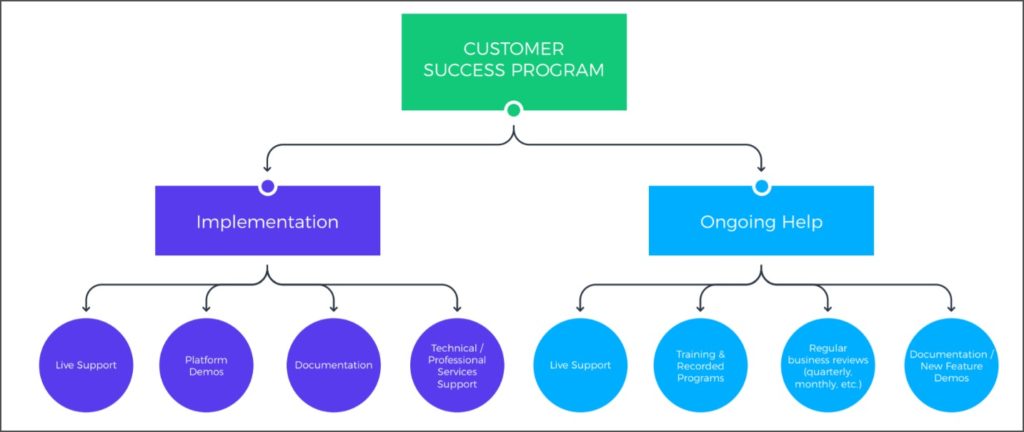Updated in March, 2020
Buyer personas, customer experience (CX), user experience (UX), conversion optimization, online payments, customer support, and a great shopping experience – these are all just some of the small parts that make up the big picture that eCommerce businesses need to “paint.”
But what do you do when you have all these elements in place, yet your business is still somehow not performing as well as you’d like? It might be time to take a look at your customer success program, since it could be what’s keeping you from reaching your goals.

Customer Success is a long-term strategy built around helping customers achieve their desired outcome while maximally using your product. From an operational perspective, the customer success team designs proactive programs and processes which enhance the customer experience, based on the customer data obtained from each interaction with them.
Customer Success has originally appeared to address a pressing need of the SaaS industry – churn reduction. Although it is still an important pillar of your retention strategy, a strong Customer Success program now is also a new growth engine for your overall business.
The purpose of the customer success team is to help your customers with everything they need to achieve success while using your product. Essentially, Customer Success Managers (CSMs) assist customers in post-purchase stages, including onboarding, engagement, renewal and retention, or advocacy. More than that, CSMs consult with customers and get feedback, report success metrics, and identify cross-sell and upsell opportunities, among others.
If your customers are happy with your product or service, they will become your advocates and tell others about you. Additionally, keeping a current customer can require far less effort and expense than finding a new one.
In the end, achieving customer success means more happy customers, and an increase in revenue for your business.
Not convinced?
“Customer success is where 90% of the revenue is,” according to Jason Lemkin, venture capitalist and founder of SaaStr.
Here’s what the experts say your business should have in place for your customer success strategies:
1. Know as much as you can about your ideal customer
Before you start building a customer success program, get to know your ideal customers and their purchasing/engagement habits. Map their customer journeys to determine what your customers need from your product, which devices/ touchpoints they use to interact with you/your product, where they work, if they use your products at work or at home, how frequently they use your service, and what they expect from your brand and your product.
Basically, you need to find out everything there is to know about what your customers want.

“Your ideal customers are: Customers who love your product, use it, and tell other people about it because they love it so much. You can identify which of your existing customers fall into this category by tracking social mentions, but you can also just ask.” – Nichole Elizabeth DeMeré, SaaS Consultant & Customer Success Evangelist.
On the flip side of this, be careful about what customers you accept – those who are a bad fit for your business will not help you grow.

“If you knowingly allow bad-fit customers to be acquired, nothing else you do in Customer Success will have the result you’re hoping for, as those customers – no matter what you do – will never achieve their Desired Outcome.” – Lincoln Murphy, Customer Success Consultant.
2. Be selective about the success metrics you track
Don’t just build a customer success program and let the team run it without staying engaged. You will not be able to improve your program if you cannot measure its results.
Ask for monthly reports and adjust your strategy based on these customer success metrics:
- churn rate
- customer health score
- Net Promoter Score (NPS)
- success potential
- success vector
Also align these with the revenue customers bring (the 80/20 rule still holds true).
You can also track tactical metrics such as advocacy actions, referrals, and so on, which provide:
- Evidence that the client is happy
- Tools for bringing in new business.
Depending on who is part of the customer success team (sales, marketing, support, product), you might want to adjust the goals of the program, so that everyone can make a meaningful contribution. This way, you avoid a misalignment of goals that keeps the team from achieving the overall desired outcome.

“There’s no silver bullet. Every company is different. You have to define success for your own customers, company, and culture.” – David Apple, Director of Customer Success at Typeform.

“There are multiple metrics, one of them which is critical is the level of adoption and usage of a product, because everyone is busy and if they are not using your product probably they have other priorities meaning that your product is not really delivering to their satisfaction. So the first challenge is, to get the right sensors into your customer and it’s what they do with your product and how often, what is the breadth of usage and also other dimensions of customer information for example support tickets, CRM information, billing information, marketing information, and so forth.” – Guy Nirpaz, Founder and CEO at Totango.
3. Know your clients’ metrics for success
Align your success metrics with your clients’. Measure and track THEIR metrics for success, and share knowledge and expertise as well as best practices that will help them utilize your product better and achieve better outcomes. Have CSMs meet regularly with clients (monthly, quarterly, or as often as your business dictates) to help facilitate this.

“You have to be focused on your customer first, and your company second. Customer Success must be defined by the extent of value your solution provides to your customers. The higher that value is, the greater your ability will be to see significant monetary and non-monetary returns.” – Boaz Maor, Customer Success Advisor.
With help from these interactions, review and adjust your customer success program goals regularly (yearly/quarterly). When changing something, have in mind the return on investment and the impact on client satisfaction. Increasing and retaining revenue is the first objective of every business, but don’t try to achieve it by any means. Do it by keeping customers happy.

“A VP of Sales wants to close more revenue. Not just retain revenue. But in Customer Success, renewing, even without any upsell, is usually Job #1. Keep the customers happy, and in the end, all is good. That’s what CS is all about. There is an inherent conflict here with Account Expansion, at least at the margin, and often with the biggest accounts. Customers that have little room to land-and-expand won’t get the same treatment from sales as an account that has a lot of room to grow. I don’t like this misalignment, personally. It always worries me.” – Jason Lemkin, venture capitalist and founder of SaaStr.
4. Be patient with your customers
Don’t expect to set up and run a customer success program today and see results tomorrow. Customer success is about nurturing clients so they become advocates, a process that takes a lot of time and resources, but which will certainly pay off in the end. If you have a wide pool of roaring happy customers, dying to express their satisfaction, results may indeed show up earlier. In any case, track the implementation of the program and frequently adjust what isn’t working.

“Customer success doesn’t pay off in just one quarter. You have to invest in the long view.” – Danielle Morrill, CEO of Mattermark.
5. Use product updates wisely
If you’re running a software or SaaS business, then you’ve probably struggled at some point with how to deliver smooth product updates. It’s key to adjust the way you communicate updates, depending on their timing and importance.
For small updates or bug fixes, you don’t want to disturb users with extensive communication – an in-product note or an email should be enough.
For updates that impact the way they use the product, give them a heads up and help them embrace the changes through your customer success or support teams. Turn the update into a big event, re-emphasize the value of your product, and make sure they understand you are growing and help them grow as well.

“To ensure customers maximize the value from a constantly evolving product, a startup must provide on-going training and persistent education in order to achieve engagement and true product/market fit.” – Tomasz Tunguz, venture capitalist at Redpoint Ventures.
6. Educate
Educational content is essential to drive leads further into the sales funnel. Having this in mind, educational content can be designed for each stage in the buyer journey and for each buyer persona. However, marketers should not stop providing content once the purchase has been completed.
Educational content is a major part of your customer success efforts, as it helps in fostering customer loyalty and retention, and ultimately makes those customers advocates of your brand. Post-purchase pieces of educational content include in-product demos, how-to guides, training sessions, or case studies. These can be used to effectively demonstrate to customers how they can use your product on their road to success and how it will return their investment. In the end, any of the content used in the previous stages of the buyer’s journey can be also used in the post-purchase stage. The only condition here is to produce content which helps customer maximize their use of your product, and even discover new ways in which to use it.
Note: be careful of the pitfall of burdening your customers’ cognitive load with too much content.

“Making sure your customers have the latest education about your products and services, as well as industry marketing material, will instantly help ensure that your customers know you’re in it for them.” – Liz Pochup, Customer Success Strategist.
7. Connect with customers via multiple channels
You can send dozens of emails and newsletters, but these might not be effective in reaching enough customers or getting the engagement you expect. And it won’t be because you don’t share valuable content or because the templates are not good enough; chances are, the problem is that customers simply aren’t encouraged to reply.
The same holds true for social media – just posting company updates and sharing multimedia content isn’t going to cut it if people don’t engage with what you share. Ask customers to reply, and share and encourage them to do so via multiple channels, not just email and social – see what works best for your audience.

“Twitter allows you to hear directly from anyone in an unfiltered way. Businesses can receive feedback directly from customers. At Slack, we read and reply to every question and comment we get on Twitter. It’s an invaluable source of feedback — both good and bad — that helps us understand our customers better.” – April Underwood, VP of Product at Slack.
8. Get Personal
Personalization is one of the most popular trends in eCommerce. Customers want to be approached individually, with solutions based specifically on their needs. Reminding customers what they’ve achieved and setting milestones in their use of your products strengthens customer relationships, encourages them to keep learning, and paves the way for success stories.

“Personalization plays a key role in modern transactions. The entire customer experience needs to be personalized and users need to monitor their situation and the progress they’re making. Keep reminding users of all the milestones they covered at each step and what results they accomplished. Adoption reports and dashboards are useful to visualize achievements.” – Andy Mura, Head of Marketing at Userlane.
9. Put the Client in the spotlight
Leverage existing customers in your marketing efforts, not just for your own goals, but also to bring them additional visibility and credibility. Case studies, guest speakers at webinars, video testimonials – these are all great examples of how you can do this. A customer-centric mindset not only enhances your business, but also helps you connect better with potential clients.

“Your business will reap a variety of benefits from case studies and testimonials, but your customers will want to know there’s something in it for them, too. Be sure to highlight the advantages when presenting the idea. For example, a case study showcases the customer’s brand and accomplishments. It also puts their company in front a new potential customer base.” – Brafton’s blog.
10. Go beyond your product
Let’s face it: there’s always going to be a product similar to yours, so your clients still have a choice, even if they are currently sticking with your business. Chances are, they will not stay if you don’t continuously improve.
And remember: it’s not just about your product, it’s about the overall outcome for your client – what are they aiming to achieve by using your product and how else can you help them do that? Can a new partnership help your client use your product more efficiently or enhance certain aspects of their work? Can additional integrations or plug-ins enhance your application to make it more appealing to your client and increase their stickiness?

“After you set a precedence of value-based engagements, your customers will look forward to your outreach as they see it as an opportunity to save time, save money, or mitigate risk.” – Ellie Wu, Senior Director of Customer Experience Transformation at SAP Concur.
11. Leverage customer advocacy as a competitive advantage
The digital age has brought about new ways of doing business and promoting it. Gone are the days when potential customers only used your website and marketing materials to gain information about you. Today, user-generated content and influencers tend to be perceived as trustworthy by potential customers. On top of this, your existing customers are also out there spreading the word about you and their experience with you. Everyone can see their opinions and views, including those who are doing early research about you. And it’s a fact: most buyers prefer peer experiences when weighing opinions about a company.
Instead of letting your existing (and enthusiastic) customers go astray, approach and motivate them to become your advocates. For this, you will need an advocacy program aligned with your business goals.
Advocacy should naturally ensue the retention phase in your customers’ journey. Apart from benefits related to increased market awareness (i.e. those more aligned to the marketing side), the advocacy program will contribute to your customer success efforts, as it focuses on customers, on nurturing relationships with them, and on turning their personal experiences into success stories.

“So healthy customers, in our mind, become advocates for you. Our customer solutions group has a mantra that our passion for customer success creates lifelong advocates (…).” – Roger Scott, ex-EVP and Chief Customer Officer at New Relic
12. Make the most out of customer reviews
You can turn customer reviews into opportunities for building customer success.
Invest time in providing responses to the criticism received via negative reviews. This way, you demonstrate that your company is proactive in listening and addressing what its customers have to say.
Also, make sure to ask your customers to provide a review, but take care not to go overboard with your requests. You can ask them in person, at the moment when they are most engaged, or using an incentive.

“But then, I think the question would be like ‘How do I identify real advocates across my customer base, beyond just an NPS?’ The easiest way to do this is with reviews (…). So, let’s start building advocates with people who will do a detailed review.” – Andrew Stapleton, VP of Customer Success at G2.
13. Align customer success with other teams
Customer Success depends on other departments and, in turn, other departments are impacted by Customer Success. Therefore, all departments which involve contact with the customer, i.e. sales, marketing, support and product, should be aligned with the Customer Success department:
- Cross-team collaboration will result in a more efficient onboarding for customers.
- CSMs will be able to coordinate resources form sales and product, for example, to address the customer problems.
Customer Support and Customer Success both imply prime contact with the customer. But, even so, their functions and objectives do not fully converge – while Success has a high-level view of the customer, proactively helping and educating them to implement and use the solution, Support reactively executes granular customer requests, of a more tactical and technical nature.
Sales and Marketing both benefit from the insights provided by the Success team. By directly interacting with the customers, the latter can better understand their goals and pain points, translating them into insights that can be used by Marketing in its content and copies, and by Sales in its pitches.
Finally, Product benefits directly from the feedback that the Success team gets from the customers (such as what features they enjoy the most, which features are lacking, etc.). In turn, Product helps the Success team fully understand the product so it can effectively onboard and train the customers.

“Support is very tactical and benefits from informed execution, whereas success tends to be high level strategy. I believe that both are critical for customer success.” – Ryan Engley, VP Customer Success at Unbounce.

“The ongoing challenge for every customer success management team is getting urgency buy-in from other teams. The only way to overcome this challenge is to have leadership of all teams strategize priorities together. Team members in those organizations will always follow what their leaders expect instead of pleas from other teams to work on something now. Customer success has to be everyone’s focus!” – Kate Nasser, The People Skills Coach™.
14. Start with a customer-centric strategy
As counterintuitive as it may sound, customer success doesn’t start with the customer, but with you. It’s essential to embed a customer-centric philosophy within the organizational culture. All departments and teams should understand that this is a coordinated effort, not an isolated task with the Customer Success department as its sole owner. Making this a core value is a good starting point, which should be followed by translating it into business operations.
Customer success is, in fact, built on three pillars – extra customer value and great customer experience delivered across the entire customer journey. And each team has its fair share of contributions for these pillars.
Each team should be proactive in collecting customer data (via any channel, including traditional surveys and chats, but also during in-person meetings or direct calls). Based on this aggregate data, it’s critical to extract insights and address them (in all operational areas, not just in terms of Product). Learn your customer lifecycle, review the customer-facing processes, and devise new onboarding processes, training programs, etc. based on the findings of your research. Rinse and repeat, and that’s how you successfully approach customer success holistically.

“So here’s the equation we use: Customer success is bigger than customer success management. (…) Customer success management is important, it’s a real job, a real discipline. But customer success is bigger than that. Customer success is a company-wide philosophy, and everyone has to be bought into it from the top down.” – Dan Steinman, Chief Evangelist at Gainsight.

“People focus on what’s in front of them and data drives actions. Take all of the relevant data, put it in front people as they engage with customers, so they can make better decisions that provide value to the customer. Also, break down the work into pieces, iterate proof, and repeat the process.” – Guy Nirpaz, Founder and CEO at Totango.
15. Always keep an eye on the trends
Customer success is a relatively new field, having first appeared in the mid-2000s. Stemming exclusively from the SaaS industry, it was initially developed as a solution to churn reduction, and has evolved formally as a new business function ever since. New roles have been introduced, and other verticals outside of SaaS have started adopting this approach. Best practices are still emerging, but one thing is certain — customer success is here to stay.
A combination of art and analytics, customer success is constantly changing and adjusting to trends. McKinsey talks about the new wave called customer success 2.0, Lincoln Murphy introduces the Customer Success-driven Growth. New trends in this field appear every year, and paradigm shifts occur (for instance, customer success is no longer a siloed discipline, but a company-wide philosophy), so it’s clear that you must be constantly up-to-date with what is happening in this field.
Conclusion
Customer success is indeed a fascinating field as its only secret pertains to proactivity. In short, customer success is a long-term strategy focusing on identifying and seizing the opportunities of helping customers achieve success. The data facilitated by the tools of the digital age (such as predictive analytics and tech solutions) only comes as a support for this bigger purpose.
Because it’s an emerging field, however, customer success should be carefully managed. There are many pitfalls derived from the fact that the field is still formally establishing itself – customer success is not limited only to a dedicated department; it does not entail only churn reduction, customer satisfaction/delight, and education about product usage. It is certainly more than customer support (in fact, they don’t actually overlap).
We hope these tips were helpful.
How do you make sure your customer success program is effective? Share your tips in the comment section below.





